BoatNews.com

Build your own mini catamaran, a guide for amateur builders
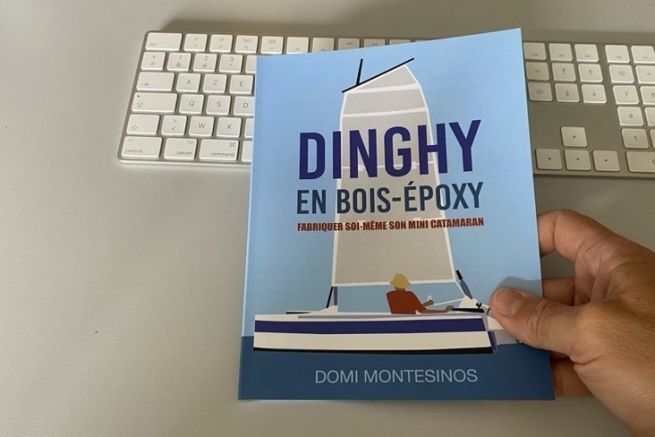
Building a small catamaran that can be used as a dinghy or even as a small dinghy: this is what this little booklet offers, with all the plans to help you achieve this. If you are tempted, Dominique will accompany you. Follow the guide!
Dominique is an autodidact with a passion for everything. He has built his life on multihulls. He also likes to tell it in several books ( find here Dominique's books ) when he's not tinkering with his boat ( find here Dominique's choices for a power catamaran ). When he has to think of a dinghy for his latest catamaran , it is naturally that he imagines a dinghy with 2 hulls.
He therefore sat down at his drawing board (the one in the saloon, of course) and designed a 3 m long epoxy plywood dinghy that would be stable and voluminous without being too heavy. In his little guide "Dinghy in Epoxy Wood", he explains how to build this dinghy . A construction within the reach of an amateur.

The book is divided into 2 parts: the first one tells and explains the whole construction (24 pages). The second part includes all the plans as well as some photos of the construction and the annex in its final version.
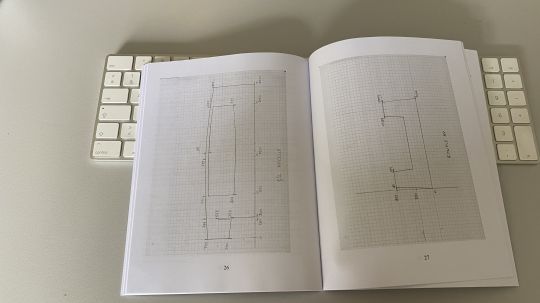
With this little book in hand, you will be able to build your own annex. However, you will have to reread the text several times to fully understand the assemblies and the different steps. Some key elements are also missing, such as the final technical data sheet of the annex (length, width, weight...). Finally, the builder who would like to start the project will have to think carefully about how to procure materials. No data on the number of sheets of plywood or the quantity of resin are provided. Dominique warns that this adventure is "primarily aimed at experienced handymen".
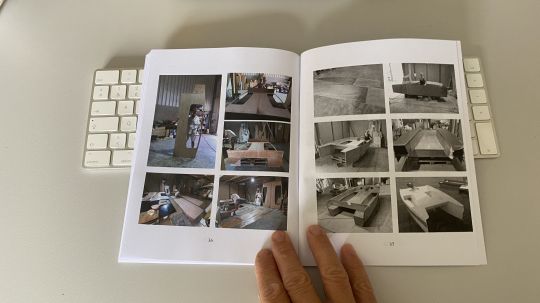
The idea of proposing an annex under amateur construction is a great idea. Dominique's realization with 2 couples in place of beam for rigidity is good. The plans seem precise and the ribs well detailed. It just lacks a little depth (and detail) to help a builder who would not be as comfortable as Dominique is in the use of composite materials.
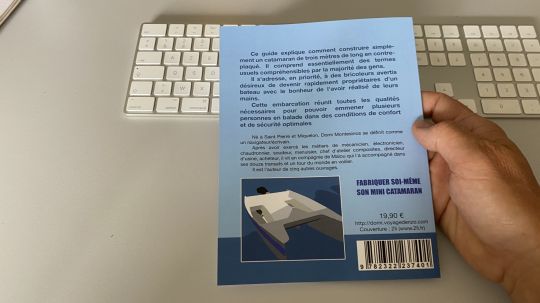
Dinghy in wood-epoxy - Build your own mini catamaran
- Domi Montesinos
- 17 x 21.9 cm
- 19.90 euros

DIY Cruising Catamaran: Complete Building Guide
As an Amazon Associate, we earn from qualifying purchases. We may also earn commissions if you purchase products from other retailers after clicking on a link from our site.
A brand-new cruising catamaran can set you back a hefty amount of money. However, a DIY cruising catamaran provides a more affordable way to own your own boat. While building a large boat can be an extremely challenging and time-consuming experience, nothing beats the pleasure of bringing your own boat to life.
To build a DIY cruising catamaran, buy good design plans, determine your budget and find a working space. Next, choose your hull material, buy supplies and start building the mast beam. Build and sheathe the hull, install bulkheads, the interior, and finally, launch the catamaran boat.
In this article, you will find a complete guide to building your own catamaran. You will also find detailed information on why you may want to consider building your catamaran and approximately how much this project would cost. Finally, we will explore the advantages and disadvantages of building a catamaran from scratch.
Why You Might Want To Build Your Own Catamaran
Most people might think that purchasing a used boat to repair and fix it up would be cheaper than a DIY cruising catamaran. But while building your own catamaran could be an enormous undertaking, it also comes with many advantages over buying something used.
Other than the unique opportunity to create beautiful memories and experiences while cruising, sailing, and exploring beautiful coastlines, there are a number of benefits that come along with the DIY approach.
Knowing Your Boat
Building your own catamaran provides you with intimate knowledge of your boat. You will know every corner, including where to find every bolt, wire, bulkhead, rib, hose, and support as you installed them yourself. This knowledge will enhance your confidence while at sea since you will have entrusted your life to a boat whose history you are aware of and deeply connected to.
Pride of Ownership
The satisfaction you get from crafting something with your own hands is immense. As a result, the knowledge that you built your boat from scratch will fill you with absolute pride and an immense sense of achievement. Furthermore, as an owner-builder, you get to keep and enjoy the boat for as many years as you wish.
Substantial Cost Savings
Building your catamaran will work out cheaper than buying a new or even gently used boat. Though you will likely require some additional labor since doing some things will require an extra pair of hands, if you are particularly good at DIY, you will save a significant amount of money on labor costs as a whole.
Freedom To Create Your Own Designs
If you decide to buy a catamaran boat, it might not be easy to find one that meets your unique needs. However, instead of choosing from production boats that bear traditional and outdated designs, you can come up with an ultra-modern design or style for your catamaran. You also get to pick your layout, size, and equipment based on your taste and budget.
Great Learning Experience
Building your own boat will help you pick up numerous skills that will come in handy later when sailing your boat. As much as you might still require an expert to help you with specialized skills like carpentry or wiring, your new skills will serve you well. This will also be beneficial when it comes to your boat’s maintenance and fixing things for yourself.
What To Look For in Catamaran Boat Designs
When deciding on the type of catamaran boat to build, you may want to choose a design that’s simple and easy to build. This is because doing so will allow you to spend a shorter time building the boat.
You also need to have a set of requirements to guide you in choosing your design or what you might call an ideal cruising catamaran wish list. This is essential because, ultimately, you want to build a boat that offers outstanding qualities such as:
- Delivers good speed
- Affordable to own and operate
- Agile, strong, and easy to maintain
- Has a high resistance to capsizing
- Great for sailing and cruising
- Delivers a comfortable and easy motion underway
- Good handling ability and high performance under sail
- User-friendly embarking and disembarking
- Provides ample living and accommodation space
- Presents a reasonable resale value
It’s worth noting that, in general, catamaran boats tend to offer a fair resale value mainly because of scarcity and the high price accorded to production models. So, if you build a well-constructed catamaran, you are bound to get a return that’s much higher than the cost of materials upon resale.
It’s also good to consider whether the design you settle on is from an established designer. This is significant because documentation of the building process is just as valuable when it comes to selling the boat.
How Much Would It Cost To Build Your Own Catamaran?
The cost of building your cruising catamaran will depend heavily on the size of the boat you plan to build and the skills you bring to the table. To give you an idea of probable costs, a professionally built 40 foot (12.1 m) long cruising catamaran could go for up to $300,000.
Though building it yourself will undoubtedly be cheaper, most DIY boatbuilders tend to underestimate the expected costs. Your final costs should cover not only the cost of material and equipment but also the labor and time it would take to come up with the final product.
If you were to build a 40-foot (12.1-meter) catamaran, your cost of materials would range between 20-30% of the total cost. Therefore, for $300,000 total, the boat’s materials would range between $60,000 and $90,000. The hull tends to range between 15-35% of the total build. Again, this depends on the finish and furniture.
But before you even start working on the DIY project, you will need to figure out where to do the work. If your home has ample space, then you can opt for a backyard building. But if you live in a small apartment, then you might want to consider renting a small garage at first and then move on to a boatyard later. This is one of the significant costs involved in building your multi-haul.
What You Will Need
To get a clearer picture of how much the entire project would cost, let’s have a look at what else you will need to purchase.
- Good design plans
- Working space
- Ground tackle
- Matting and roving
- Equipment such as the engine, windows, rudders, deck fittings, mast, and rigging
In addition to the above, you also need to install plumbing and electricals. You may also want to consider going electric rather than using diesel. Not only will this drastically reduce your maintenance costs, but you get to use the regenerated power for all of your housing needs while sailing.
Some catamaran boat designs help you save costs by advocating the use of less expensive corpus materials. Most of the material goes directly into making the boat, which means there is hardly any wastage on vacuum bagging . With this method, there are few molds and temporal building forms and fewer fillers to grind off as waste. All these factors reduce the time and cost it takes to build your catamaran boat.
That said, building a boat of any kind is a huge financial undertaking. As such, you still need to have the financial ability to keep building; otherwise, your project will stall or take much longer than anticipated. Instead of enjoying yourself and making memories cruising to faraway lands, you might end up spending all your time building a seemingly never-ending boat.
To reiterate, this project is more of a labor of love, given that it involves a tremendous amount of manual work. Calculating an hourly rate on the time spent building the boat and adding this cost to that of materials may make it seem a very pricey exercise. However, it is vital to understand that your time matters, and every hour you spend working for “free” should be included.
With that in mind, you need to ensure that you are fully devoted to the boat construction project and are sure you want to do it before you begin. Stopping halfway because it seems like too much work would be incredibly costly.
How To Build a Catamaran
When it comes to building a cruising catamaran, you have 3 main options:
- You can buy an old boat and refurbish it.
- Purchase a bare hull plus deck molding for a home-boat building.
- Start from scratch and build everything, including the hull, on your own.
As mentioned above, renovating an existing boat may end up being more costly than starting from scratch. To build a catamaran boat from scratch, follow the below step-by-step guide.
Prepare the Essentials
Before you jump into such a large project, there are several important aspects to consider:
- Buy your plans from an established catamaran designer. You can also get inexpensive, easy-to-build catamaran designs online.
- Get access to a large working space or build a shed . Depending on your climate, you may need to opt for climate control to avoid an excess of moisture in humid areas.
- Decide on your choice of hull material. This could be fiberglass, aluminum, steel, wood, or ferroconcrete.
- Start working on a bill of materials estimate. Include everything that you think you need to get a better idea of the initial costs.
Build the Mast Beam
Using wood and epoxy, cut and glue together the pieces of wood that will form the mast beam. Most of the work at this stage can occur in a garage since it involves building small parts. Still, the work could take up to 4 months, so be prepared to put in long hours.
Build the Boat Hull
Now, it’s time to build the boat’s hull. A catamaran comprises two hulls which are connected with a deck. Below is a short video showing how to build a hull mold:
This work requires a larger facility, so you might need to move out of the garage and into a boatyard. If you don’t have access to a larger workshop, consider building a shed where you can work as you do the construction. Make sure there’s enough room to fit the boat and also allow you to work comfortably. To cover the shed, you can use opaque white tarps.
Sheathe the Hull
Get all the materials you require for this stage in the construction, such as lots of resin, fiberglass, and foam for use in the hull cores. You’ll also require matting and glass roving to sheath the hull .
Sheathing helps to make the hull impervious to water and other marine borers. But first, you need to prepare the hull using a rotary sander. To make it as smooth as possible, use light, sweeping strokes. This is a very dusty task so be prepared to wear a facemask and safety goggles.
Install the Bulkheads
Next is installing the plywood bulkheads . You might need to call in friends to help turn the hulls or use a crane. In this step, you will need to laminate the hull sides on the molded hull panels and bond them above the bulkheads. Ensure the bulkheads are snug and sealed in place.
Construct the Interior Structure
Over the next couple of months, the boat work will involve joining the hulls together with the beams that you had made back in the garage. Then, install the cuddy cabin, decks , and the cockpit . Soon the boat will start to take the shape of a catamaran.
Next, proceed to construct the major structural components such as stairs, hatches, mini-keels, and the interior. Then comes the work of fairing the boat, which is quite labor-intensive.
Finally, it’s time to apply primer on the catamaran boat and start the paintwork. Before painting the boat, you will need to do additional sanding to finish off the two layers of primer as well as fill all the pinholes. Since it’s a large boat, the catamaran has lots of surface area; thus, the sanding could get extremely exhausting—mentally and physically—at this point.
The painting can take a while, too. The hulls are the easiest to paint, but the topsides, non-skid, as well as masking and prepping could seem never-ending.
The final stretch involves working on the center bridge deck cabin and other final touches like installing the engines, electricals, and plumbing. This is also the time to fix the rudders, rigging, mast, windows, and deck fittings.
Launch Your Cruising Catamaran
After many months or years of hard work, your cruising catamaran is finally ready to test the waters. After lowering the boat into the water, check carefully in case there are leaks. If none, you can set up the sails and take your catamaran out for your first cruise.
Below is a short video that takes you through the entire boat-building process:
If you don’t have deep pockets, don’t despair. It’s also possible to build an inexpensive catamaran boat, as shown in this post from the coastal passage .
The Pros of Building a Catamaran
Though it will be a costly endeavor, there are so many things to look forward to should you decide to build your own catamaran:
- It can be lots of fun.
- You get to have a new boat.
- It’s an excellent hobby for DIY enthusiasts.
- The effort is rewarding.
- It offers a great learning experience.
- You get the exact kind of boat you want.
- You can alter building plans and tailor the boat to suit your specific needs.
- It might be cheaper than buying a new boat.
The Cons of Building a Catamaran
Though there are a number of positive aspects to a DIY build, it is just as important to keep in mind that it won’t always be easy:
- Maintenance costs can be quite high.
- It’s both mentally and physically exhausting.
- It might require some technical know-how.
- It can take many months or even years to complete.
- It requires a lot of commitment to finish the DIY project.
- It might be challenging as well as expensive to get insurance.
- You will spend almost all your free time building the boat.
DIY Cruising Catamaran Tips and Tricks
If you are new to boat building, it would be a good idea to build a small boat first. This would give you a good indication as to whether you’d enjoy tackling a more extensive project like building a catamaran. Again, if you are the handy type, fixing your own electronics could also save you a significant amount of money.
Here are more tips and tricks to get the most out of your DIY cruising catamaran:
- Lower your costs. Bring down your costs even further by sourcing for parts and supplies at marine surplus outlets, Craigslist, eBay, or wholesale suppliers.
- Enhance your resale value. Most home-built boats are not easy to sell since they tend to be too customized. To enhance your resale value, it’s advisable to work with a standard design from a well-established naval architect.
- Follow the design instructions. Make sure to follow the designer’s instructions regarding the type of materials and tools to use during the build to avoid making costly mistakes.
- Maintain your original budget. Avoid any additional customizations once you have started building the boat. Using good plans and sticking to them ensures that your budget doesn’t spiral out of control.
Final Thoughts
Building a catamaran is about more than saving money. It’s fun, exciting, fulfilling, and can be a great learning experience. While it might take many months of back-breaking work, comparative shopping and sourcing for materials will help you save a lot of money. Still, at the end of it all, you’ll have a beautiful catamaran boat, all ready for your first cruising adventure.
However, if you have neither the time nor the energy to build your own catamaran from scratch, refurbishing an existing hull might prove faster and easier. It also works out much cheaper than buying a new boat.
Owner of CatamaranFreedom.com. A minimalist that has lived in a caravan in Sweden, 35ft Monohull in the Bahamas, and right now in his self-built Van. He just started the next adventure, to circumnavigate the world on a Catamaran!
One thought on “ DIY Cruising Catamaran: Complete Building Guide ”
Hello, I am a French Quebecer who is original, imaginative, creative and who finds that all boats and catamarans have a huge flaw and a very big lack of logic. I would have a brand new concept…. I am sending this message to any catamaran creator – designer to make those who have the opportunity and the intelligence to want to know about my innovative idea which will finally upset the market much richer. An idea that will totally change the concept of sailing, navigation and save so much worry!! All I would ask for is a small percentage of each sale of the new product. To be able to make me produce one when I have enough!! It is certain that like that, you just want to tell me: come on Mr. Lessard give us your idea but do not take your word to help me in return! But, if you are the kind of man to have only one word and maybe have a proof of your good faith if the realization of the project would make it… I will be very happy!! Giving it to everyone wouldn’t bother me either…. all I would like is to be able to find flax fiber (too expensive carbon) to be able to try to make my catamaran myself. Because not rich! Have a nice day and looking forward to having a message!!
Leave a Reply Cancel reply
Your email address will not be published. Required fields are marked *
Save my name and email in this browser for the next time I comment.
Recent Posts
Must-Have Boat Gear for Catamaran Sailors!
Sailing is probably the most gear-intensive activity I've ever done; there are so many decisions to be made about what gear to buy now, for tomorrow, and what to definitely never buy. The gear on...
6 Best Trailerable Trimarans For Bluewater and Coastal Sailing
Having a boat costs a lot of money, even when you are not using it, marina fees, etc. And once it is in the water most sailors never go very far from their "home marina" and sailing will be somewhat...


How To Build A Catamaran? (A Step-By-Step Guide)

Are you excited about the prospect of building your own catamaran? With a little research, planning, and the right tools, you can turn your vision into reality in no time.
In this step-by-step guide, well show you how to make the most of this incredible boatbuilding project.
From selecting the materials and planning the design to constructing the hulls and deck and outfitting the boat, well walk you through everything you need to know to build a catamaran of your own.
So, grab your tools and lets get started!
Table of Contents
Short Answer
Building a catamaran requires careful planning and a lot of patience.
The first step is to decide on the design and the materials you will use.
You will need plans for the project, along with lumber and other materials such as fiberglass and epoxy.
The next step is to build the catamaran frame, which involves cutting and fitting the wood pieces together to form the hulls and decks.
Finally, you will need to attach the decking, add the rig and sails, and finish the project with paint and varnish.
Benefits of Building a Catamaran
Building a catamaran can be a very rewarding experience.
Not only will you have the satisfaction of creating something with your own hands, but you will also have a boat that is uniquely yours.
Catamarans offer many benefits over traditional monohull boats, making them an ideal choice for those looking for a reliable and efficient ride.
These benefits include greater stability, more space, improved fuel efficiency, and greater speed.
Stability is one of the biggest advantages of catamarans.
The two hulls provide a wider base that helps to keep the boat from rocking and rolling in rough waters.
This makes for a much smoother and safer ride, even in choppy waters.
Additionally, the two hulls create an open area between them that is perfect for storing equipment, making it ideal for longer trips.
Catamarans are also more fuel efficient than monohulls.
This is because the two hulls provide lift, allowing the boat to glide through the water more easily.
This means you won’t need to use as much fuel to power your boat, allowing you to save money in the long run.
Finally, catamarans are faster than monohulls.
This is due to the increased surface area of the two hulls, which allows the boat to move more easily through the water.
This makes them ideal for those who want to travel quickly and efficiently.
Overall, building a catamaran can be a fun and rewarding experience.
With the right materials and tools, you can create a boat that is unique to you and offers many benefits over traditional monohull boats.
With the right planning and construction process, you can create a catamaran that will be the envy of your peers.
Selecting the Materials

Selecting the right materials is a crucial step in building a catamaran.
The type of material you choose will depend on the size and type of catamaran you are building, as well as your budget and experience.
Catamarans are typically constructed from wood, aluminum, or fiberglass.
Each of these materials has unique advantages, so it is important to research the pros and cons of each before making a decision.
Wood is the traditional material used to build catamarans and is often the most cost-effective option.
Wooden catamarans are strong and stable, and they can be custom-built to any size or shape.
However, wood requires a lot of maintenance and can be susceptible to rot and water damage.
Aluminum is a great option for larger catamarans, as it is lightweight and resistant to corrosion.
It is also relatively easy to work with and can be welded together to create a strong and durable structure.
However, aluminum is a more expensive material and is not as flexible as wood or fiberglass.
Fiberglass is the most popular material for building catamarans, as it is lightweight, strong, and resistant to corrosion.
Fiberglass is also relatively easy to work with and can be shaped to create unique designs.
However, fiberglass is also the most expensive option and can be difficult to repair if damaged.
Once you have selected the material, it is important to purchase the right amount for the project.
Make sure to measure the catamaran carefully and purchase enough material to account for any mistakes or waste.
It is also important to purchase high-quality materials that will last for years.
With the right materials, you can build an amazing catamaran that you will enjoy for years to come.
Planning the Design
When planning the design of your catamaran, youll need to consider a variety of factors, including the size, shape, and type of material youll be using.
Consider the size and weight of the catamaran and the type of water it will be used in.
Youll also need to think about how the catamaran will be used, such as for recreational or commercial purposes.
When it comes to the shape of the catamaran, the most common design is the two-hulled V-shape.
This shape is ideal as it offers stability and is easy to maneuver.
However, depending on the type of use, other shapes, such as the three-hulled catamaran, may be better suited.
The material you choose for your catamaran will also play a role in the design process.
Common materials used to build catamarans are wood, fiberglass, aluminum, and composites.
Each material has its own advantages and disadvantages, so its important to research and select the best material for your project.
Finally, when planning the design, youll need to consider the outfitting of the boat.
This includes items such as decking, seating, and a helm station.
Make sure to think about the type of equipment youll need for your catamaran, and consider how it will be installed.
By taking the time to plan the design of your catamaran, you can ensure that you get the best possible outcome.
Doing your research, selecting the right materials, and choosing the right outfitting will all help you create an amazing catamaran that will last for years to come.
Constructing the Hulls and Deck

Constructing the hulls and deck of a catamaran is perhaps the most important and time-consuming step in building a catamaran.
You will need to plan the design of the hulls and deck carefully to ensure that your catamaran is strong, stable, and seaworthy.
When constructing the hulls, you will need to use strong and light materials that are suitable for marine environments.
Fiberglass is a good choice for this, as it is strong and lightweight.
You will need to cut and shape the fiberglass to fit the shape of the hulls, and you will need to use a strong adhesive to bond the pieces together.
The deck of the catamaran will need to be strong and stable enough to support the weight of the passengers and cargo.
You will need to construct the deck out of marine-grade plywood, and you will need to use a strong adhesive to bond the pieces together.
You may also need to add extra support beams to the deck for added strength.
Once the hulls and deck have been constructed, you will need to sand and finish them to ensure a smooth and watertight surface.
You may need to use a sealer or primer to protect the wood and fiberglass from the elements.
Finally, you will need to attach the hulls and deck together.
This can be done with bolts, screws, or other fasteners.
You may also need to use a water-resistant sealant to ensure a watertight connection between the hulls and deck.
Outfitting the Boat
Outfitting a catamaran is an essential part of the build process.
Once the hulls and deck are constructed, you’ll need to ensure that all the necessary components are in place for a successful voyage.
This includes items such as masts, sails, rudders, and outriggers.
It is critical to ensure that the boat is outfitted with the right components for its size and purpose.
For example, if you are building a small catamaran for speed and agility, you’ll need to outfit it with a light and responsive mast and sail.
If you are building a larger craft for comfort and luxury, you’ll need to outfit it with a heavier and more resistant mast and sail.
Additionally, you’ll need to select the right outriggers and rudders for the catamaran’s size and purpose.
Outfitting a catamaran can be a complex process, and it is important to do the research and plan ahead.
Taking the time to select the right materials and components will ensure that your boat is outfitted for success.
Additionally, it is important to use quality materials and components to ensure a safe and successful voyage.
With careful planning and quality components, you can outfit your catamaran for a successful journey.
Acquiring the Right Tools

When it comes to building a catamaran, having the right tools can make all the difference.
To get started, you’ll need a variety of hand tools, including saws, drills, sanders, and screwdrivers.
You’ll also need power tools like routers, biscuit joiners, and angle grinders.
It’s also important to have safety equipment like safety glasses, ear protection, and respirators.
You’ll also need a variety of measuring tools, such as rulers, calipers, and tape measures.
Finally, you’ll need a selection of glues, adhesives, epoxies, and sealants.
With the right tools, you’ll be able to complete your catamaran project safely and efficiently.
Researching and Planning Your Build
Researching and planning your build are essential steps in the process of building a catamaran.
The first step is to become familiar with the design and construction of catamarans.
Start by researching different types of catamarans, from the small and lightweight recreational boats to the larger and more luxurious cruising vessels.
Learn about the advantages and disadvantages of the different types of catamarans and determine which type is best suited to your needs.
Once you have a good understanding of the different types of catamarans, you can begin researching the materials and tools you will need for your project.
You will need to choose the type of wood you will use for the boats hulls and deck, as well as the type of fiberglass and resin you will use for the hulls and deck.
You will also need to choose the type of engine you will use and the type of rigging and sail you will use.
Once you have selected the materials and tools you will need for your project, you will need to create a plan for the construction of your catamaran.
You will need to determine the size and shape of your boat, the types of joints you will use to construct the hulls and deck, and the type of engine and rigging you will need.
You should also plan out the sequence of construction steps, so that you can build the catamaran in the most efficient way.
Finally, you will need to research the best ways to protect your catamaran from the elements.
You will need to determine what type of paint or varnish to use on the hulls and deck, and you will need to research the most effective ways to protect your boat from the sun, wind, and water.
By taking the time to research and plan your build, you will be able to create a catamaran that is well-built, efficient, and beautiful.
With the right research and planning, you can create an amazing catamaran that will be the envy of your friends.
Final Thoughts
Building a catamaran is a rewarding experience that can be achieved with the right approach and materials.
With a clear plan, the right tools, and a good understanding of woodworking and fiberglass techniques, you can build an amazing catamaran to share with your family and friends.
So what are you waiting for? Get started on your own catamaran build today and all the rewards that come with it!
James Frami
At the age of 15, he and four other friends from his neighborhood constructed their first boat. He has been sailing for almost 30 years and has a wealth of knowledge that he wants to share with others.
Recent Posts
When Was Banana Boat Song Released? (HISTORICAL INSIGHTS)
The "Banana Boat Song" was released in 1956 by Harry Belafonte. This calypso-style song, also known as "Day-O," became a huge hit and remains popular to this day for its catchy tune and upbeat...
How to Make Banana Boat Smoothie King? (DELICIOUS RECIPE REVEALED)
To make a Banana Boat Smoothie King smoothie at home, start by gathering the ingredients: a ripe banana, peanut butter, chocolate protein powder, almond milk, and ice. Blend the banana, a scoop of...
Portable Boat Plans
- About Designer
- Plan Ordering Information

MINI-CAT
The PortableBoatPlans "2012 Portable Boat Design Contest" is over for another year, and there were two winners (tied votes). The object of the contest was simple: Develop a concept for a small homemade boat that would appeal to many other amateur builders. This year the co-winners both provided a design for a catamaran hull platform boat, with some unique differences. The MINI-CAT by Harold Krause of Texas, featured in this article, is about as basic as you can get, yet it has the potential to be much more. As drawn, it is a little less than 8 feet long and is 4 feet wide. It easily breaks down into four hull modules that are each one foot square by 4 feet long. The deck is composed of 2 sections, each 3 feet by 4 feet wide, and only 2 inches thick. Once assembled, the primary means of propulsion is with oars, or paddles, but a trolling motor is easily adapted to the boat for leisurely cruising, at around 4 MPH.
The second winner is the CAMP CRUISER by James McCabe of Dublin Ireland, a design quite similar in size to the Mini-Cat, also with a twin-hull, but with an enclosed folding cabin for overnight stays on the water. Because of the extra design detail required, the plans for this contest winner will take longer to develop.
It's obvious that the voters of the design contest favored the twin-hull designs. Is this a trend ?
In the meantime, with the plans of the MINI-CAT complete, construction work should get underway this summer. The materials list consists of 2 sheets of 5 MM plywood, and 1 sheet of 1/2 inch plywood, in its basic form. Additional materials, like 1 x 2 lumber and TiteBond 3 waterproof wood glue complete the list. Because of the simplicity of the design, the plans consist of only 26 pages, including the Tape & Glue Process of joint sealing.
The following layout drawing should provide sufficient information about the configuration and overall capability of this small, but stable, platform boat. It can support over 400 pounds easily, and will fit in all Trucks, Vans and SUV's for the trip to and from the water.
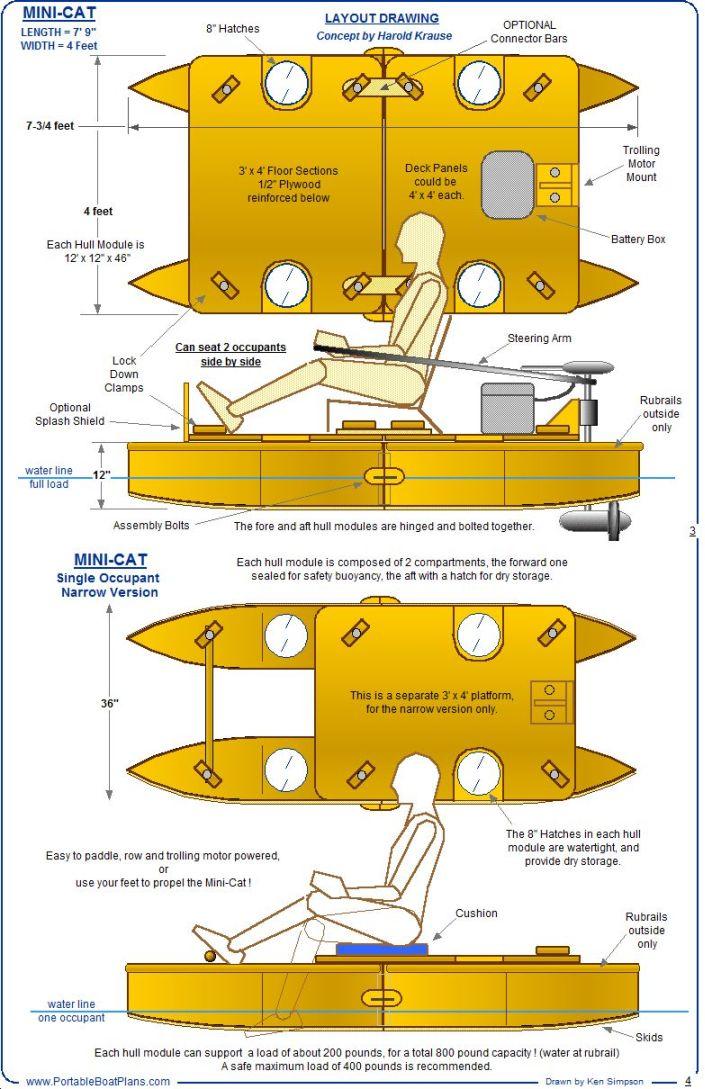
As you can see, there are no complicated shapes to this boat, all easy to cut and assemble panels. The plans do outline in some graphic detail how everything fits together, but leaves open areas for the builder to customize the build to his or her personal taste. Some of the many options might be fishing rod holders, or a fixed enclosure for a cooler. Also, the seating is pretty much up to the builders needs, and can even be a folding lawn chair, or two.
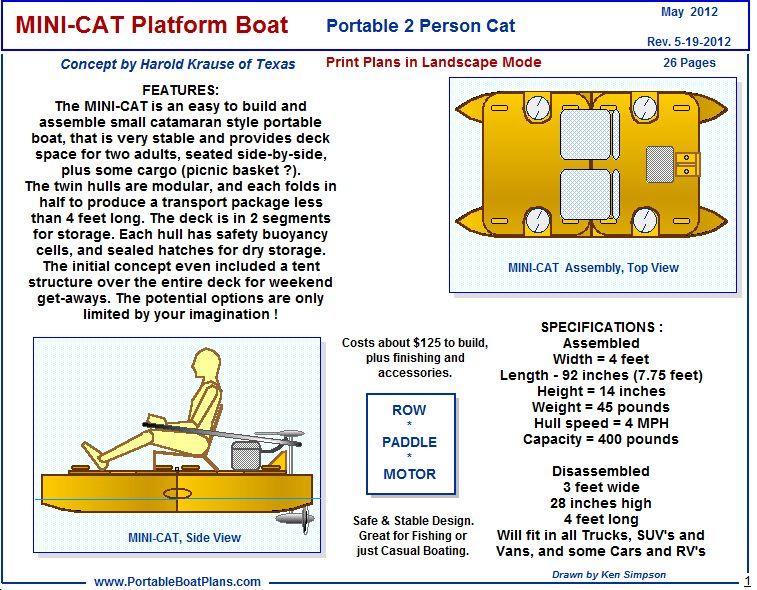
Page 1 of the plans give you a sense of what the MINI-CAT is, and what it can do. Because you sit ON, and not IN the boat, some getting used to will be expected. Perhaps you will want to add a small splash shield to the front of the deck panel, or a small canopy can be easily constructed to provide shade on those sunny days. The options are only as varied as your personal wants and needs.
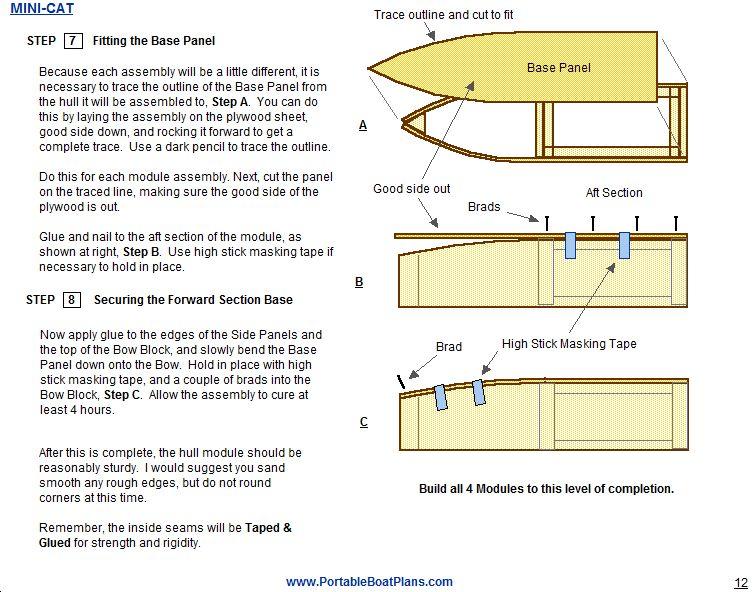
Everything starts at the construction of the 4 hull modules. These are what do the work of holding you steady, and safely, on the water. Although built of thin, light plywood, each module is strengthened by the use of 1 x 2 edge supports, and all seams are Taped & Glued for strength, and to prevent water intrusion into the plywood edges. Instructions are intentionally kept as short as possible, with only detailed descriptions where required. If the builder experiences some misunderstanding of the plans, the designer is only an e-mail away.
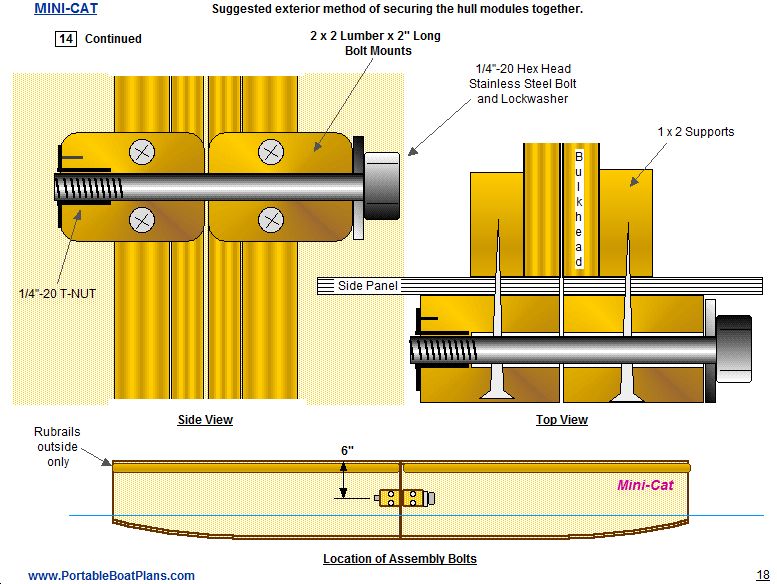
Everyone always wants to know how the whole thing is held together. The above sketch defines the Hull Module Assembly Bolt method of joining the hulls, for a secure yet easy to disassemble process. I have, over the years, tried other methods, but simple Stainless Bolts with fixed T-Nuts has proven to be the easiest to implement.
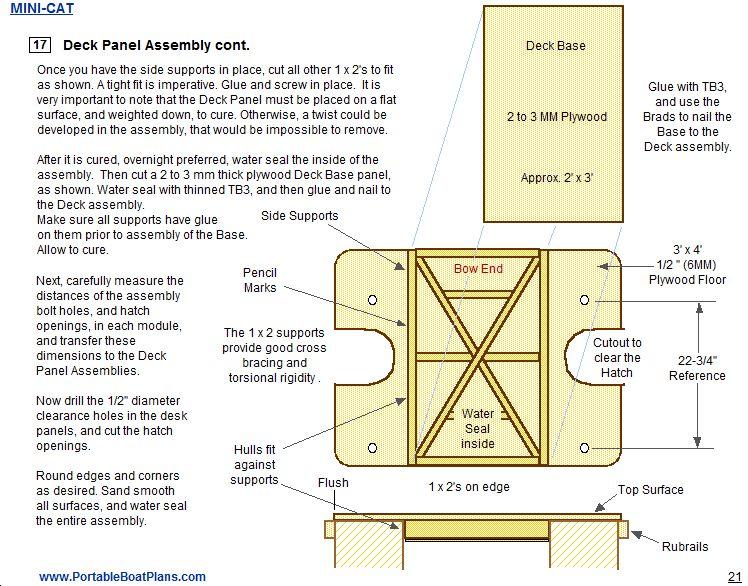
The article would not be complete without some explanation of the Platform assembly. The 1/2 inch plywood panel is simply strengthened by the buildup of a cross-laced system of 1 x 2's on edge, with a thin 2 or 3 MM plywood base cover. The interior is water sealed prior the the placement of the base, so the deck panel also becomes a buoyant platform !
Not big enough ? Simply add a foot or more to each hull module, another deck panel, and make it a family affair.
Obviously, no photos of the finished boat are yet available, but a close study of the plans should give you a sense of what the MINI-CAT is, and what it can be for you. As mentioned earlier, the basic structure of MINI-CAT can become a great starting point for a stable twin-hull, portable, safe, and fun platform boat, one that you have always wanted.
Ken Simpson
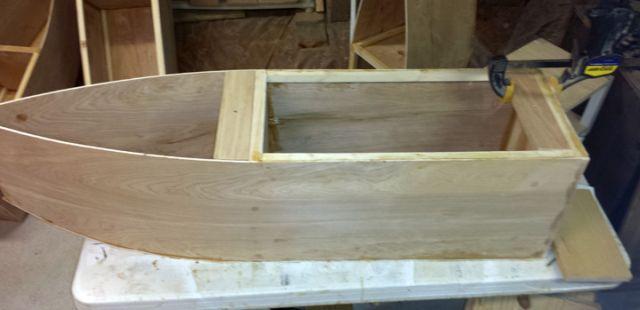
Early pontoon construction, 4 required.
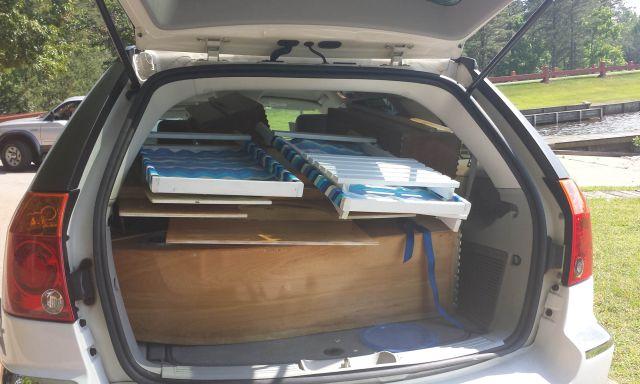
It all fits in the SUV.
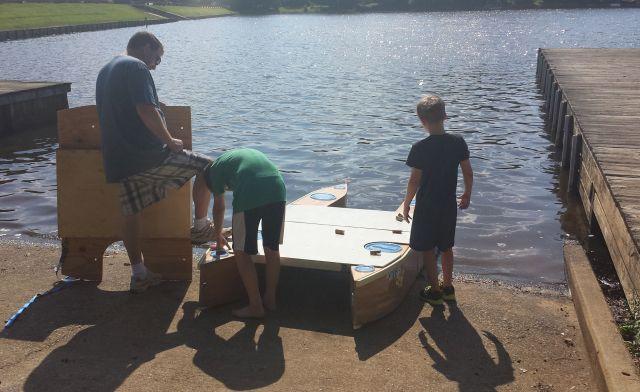
First launch. A family affair.
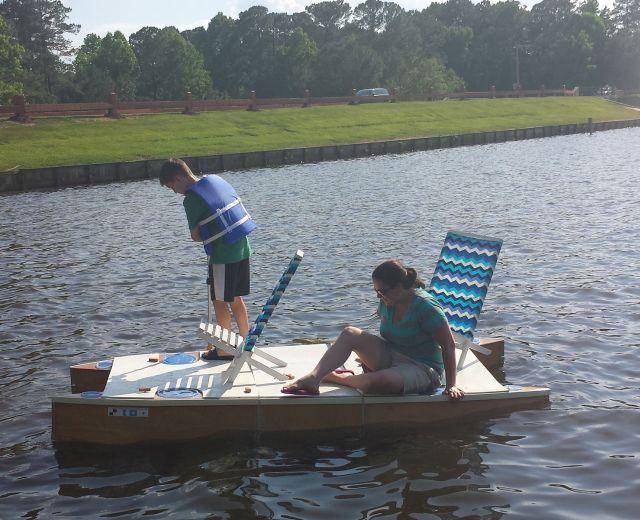
This Mini-Cat was built by Mary Anne Etheridge of North Carolina. As you can see in it's first launch, the deck had a tendency to twist. This condition has been corrected with the addition of cross braces, front and rear, to stabilize the platform. Also note the addition of a center module, necessary for greater capacity. Mary Anne plans to add a safety railing after the sea trials are completed. (June 2014)
RETURN TO HOME PAGE
Make a free website with Yola
Log in or Sign up
You are using an out of date browser. It may not display this or other websites correctly. You should upgrade or use an alternative browser .
Open Source 13-15m Catamaran Plans
Discussion in ' Projects & Proposals ' started by archie1492 , Jan 3, 2018 .
archie1492 Junior Member
Dear all, I want to create a detailed building information model for a 13 - 15 meter catamaran that is capable of being CNC cut and assembled. I need some help finding plans I can use as a basis of design. Specifically, I need the hull profile information. Section cuts through the hull will give me the ideal contours for a boat of this size. Can someone help? After weeks of searching, I still cannot find these online. For now, this is merely an exercise in my 3d modeling capability. I'd like to share my drawing work with the forum if I can get some assistance to start off. There are future possibilities I am also considering. I'm an experienced Architect & construction designer with a strong background in computer aided design. Once I've modeled the boat in 3d, I would like to flatten the various parts and create plans for the individual boat parts to be CNC cut. I would like to build a small scale model first (1:2o or perhaps 1:10) with the ultimate goal of building the boat full scale.
TANSL Senior Member
This is a very simple catamaran which, if you are interested, I can give you a lot of information. It is not a spectacular boat but it can help you in your first steps with boats. LOA = 16 m, Lbp = 14.6 m
Thanks I really appreciate it. The hull lines for the motor cat you've provided are not quite what i'm looking for. I'm specifically looking for the hull lines for a 14m catamaran sail boat. I guess there is some standard for these contours especially the area below the waterline. Check the attached document as well if anyone is interested in this.
Attached Files:
catdimension.pdf
I'm sorry, you never specified that it was a sailing catamaran. I thought that to carry out your purposes, " For now, this is merely an exercise in my 3d modeling capability ", any model was valid. Apparently, you have different purposes than, in addition to, to practice with 3D models. The better you clarify what you are really looking for, the better someone can help you.
Hi all, Here's an example of what kind of information I need to get started. Optimising Hull Lines for Performance https://www.graingerdesigns.net/the-lab/optimising-hull-lines-for-performance/ The boat shown here is a 8.5m cat sailboat. I'm looking for something a bit larger in the 14m range. Also, the images only show one of the hull profiles. I'd like profile lines for the entire boat. I will post some other images I've found online showing profile lines for smaller boats. I still cannot find any 14m hull lines. Can anyone help?
grainger_1488019480.jpg
Grainger_1488019410.jpg, grainger_1488019333.jpg, grainger_1488019265.jpg, grainger_1488019219.jpg.
Here are some other hull lines I've found online. Hope this is useful to anyone else looking for this information. Thanks!
Evergreen Lines small.jpg
Hull-lines.jpg, shark-20.jpg.
You could take any of those boats and scaleb the lines to get the desired length. Since it is only a 3D modeling exercise, you do not have to worry about anything else. You could even make a mix of 2 or 3 of those models to get the one you are looking for.
Thanks Tansl, I'd like to make the boat drawings accurate for the 14m size. Perhaps one day I will develop this into something worth building full scale. The more accurate I can draw the boat, the more I will learn about the boat design.
Maybe it does not look like it but I would like to help you. If you do not find what you want on the Internet I could draw a lines plan, strictly following your instructions, which would help you to make the 3D model. Or, if you find something similar on the internet I can adapt it to your needs and fill in the information that you indicate you need for your work. I insist that starting from the shapes of a 10 m boat you can get the shapes of a boat of 14 m, with total accuracy.
Dolfiman Senior Member
archie1492 said: ↑ I'd like to make the boat drawings accurate for the 14m size. Perhaps one day I will develop this into something worth building full scale. The more accurate I can draw the boat, the more I will learn about the boat design. Click to expand...
Cata 14m with Gene-Hull UE Catamaran 2.3_2018 01 15.ods
Gene-Hull Catamaran 2.3 User Guide_2018 01 16.pdf
Hull for cata 14m with Gene-Hull UE Catamaran 2.3_2018 01 16.pdf
Dolfiman, thanks so much! This is exactly what I was looking for. It's very interesting and probably a bit over my head at this point. I think this should work for modeling the basic hull shape. For the bridge deck and all of the stuff above the hull I can model this with a bit more creativity. Although, I'd like to learn more about understanding the center of gravity for the boat and the proper location of the mast. Are there any rules of thumb about this? Thanks again!
archie1492 said: ↑ I think this should work for modeling the basic hull shape. Click to expand...
Cata 14m V2 with Gene-Hull UE Catamaran 2.3_2018 01 15.ods
In complement to illustrate this first approach, my good friend Alain did some 3D views here attached of the hull V2 version with Multisurf (using fit for purpose ouput data in section 5. of the above file). To inspire you , some other examples of cata, more sport/day sailer oriented than the Saona 47 : - R/P 45 (Reichel-Pugh) : multihull http://reichel-pugh.com/tag/multihull/ - Dazcat 1295 : in this video, from 1:45 the launch, you can see the hulls from various angles https://www.youtube.com/watch?v=0BZF4Udda5E - SIG 45 (VPLP design) : from 1:20 you can see the winward hull fully lifted
dean 1962 New Member
archie1492 said: ↑ Dear all, I want to create a detailed building information model for a 13 - 15 meter catamaran that is capable of being CNC cut and assembled. I need some help finding plans I can use as a basis of design. Specifically, I need the hull profile information. Section cuts through the hull will give me the ideal contours for a boat of this size. Can someone help? After weeks of searching, I still cannot find these online. For now, this is merely an exercise in my 3d modeling capability. I'd like to share my drawing work with the forum if I can get some assistance to start off. There are future possibilities I am also considering. I'm an experienced Architect & construction designer with a strong background in computer aided design. Once I've modeled the boat in 3d, I would like to flatten the various parts and create plans for the individual boat parts to be CNC cut. I would like to build a small scale model first (1:2o or perhaps 1:10) with the ultimate goal of building the boat full scale. Click to expand...
- Advertisement:
Archie, I have been looking to do the same thing. Where are you at on the project? Very interested in hearing all about it. Thanks.
The Open Trawler Project!
- No, create an account now.
- Yes, my password is:
- Forgot your password?



MIKE WALLER
Yacht design.

WE SPECIALIZE IN BOAT PLANS FOR AMATEUR BUILDERS
We provide stock boat plans for both monohull and multihull sailing vessels, including sailing skiffs and sharpies. Our designs mainly feature timber construction, in plywood or cedar strip plank composite construction, using the W.E.S.T. system (wood epoxy saturation technique). Our designs are intended mainly as cruising boats, although several have done well in racing. All designs are suitable for amateur boat builders.

MONOHULLS
multihulls , photos from our builders.
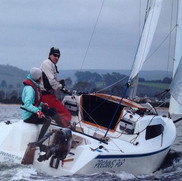
Photo galleries are provided on each design page where available
[email protected]

The Best Advanced Build System in the World
The schionning advanced build system are one of the simplest ways to build your own boat, or have a custom design built faster and more accurately by a professional. utilising duflex panels with a balsa core, large sheets are joined on their long edge to form full length hull panels, bulkheads etc similar to a giant jigsaw puzzle. once you release the tabs, your full size pieces are ready to be assembled., a pre-cut advanced build system does not only benefit the home builder, but streamlines a professional build as quantities are accurate and wastage is minimised. when having a vessel built overseas, a kit reduces the chances of local materials not being available, or delays during your project, and ensures there are no mistakes., read on below to gain a more solid understand of how the schionning advanced build system go together, where are you building.
Schionning Designs is partnered with a number of leading composite manufacturing companies with varying CNC capabilities, as well as supplying resins, hardeners, cloths and fillers. Our partners are located in different parts of the world, so where you are planning to build your boat will have an impact on which composite company is best to supply your kit.
Listed below are our composite manufacturering partners, ATL Composites located in Australia, VDL Composites located in Germany, and PBT Technologies located in South Africa.

ATL Composites (Australia)

VDL Composites (Germany)

PBT Composites (South Africa)
Starting the process.
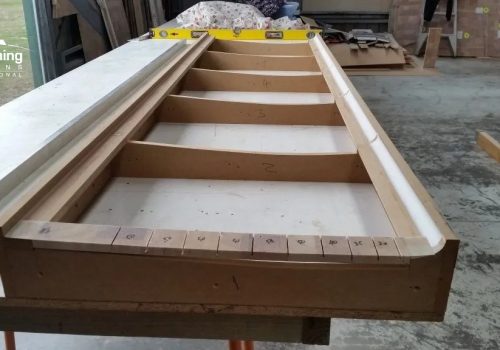
THE KIT PROCESS
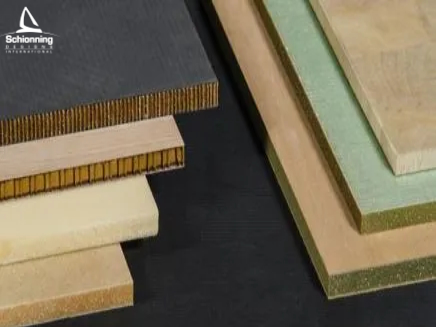
MATERIAL CHOICES

TECHNICAL INFORMATION

RECOMMENDED EQUIPMENT
- Storage Solution
- Transport Solution
- Minicat for Campers
- Minicat for Yatchs
- Minicat Factory
- Minicat Events
- Laura Dekker
- Laura Dekker’s Foundation
- Testimonials
- Minicat Guppy
- Minicat 310
- Minicat 420
- Minicat 460
- Minicat as a tender
- Parts & accessories
- Used boats for sale
- Distributor map

MINICAT MODELS
Catamaran boat.
When creating the MiniCat model range, we gave great consideration to our customers and potential sailors of small portable watercraft, the end users of this fantastic inflatable catamaran boat. We wanted to make sure that we offer a MiniCat model for every sailing level, from young sailors and beginners to experienced semi-professional, hard-core sailors.
Nowadays, MiniCat is a perfectly engineered and well-thought-out small catamaran boat that comes in 5 sizes and eight different models in a range of color combinations with an extensive selection of accessories. We also strive to support owners of all models, even those previously discontinued, so we supply and stock all spare parts for all our boats.

MINICAT GUPPY
MiniCat GUPPY is all about simplicity and speed of assembly. Due to the unique design of the floats pre-attached to the frame and trampoline, the set-up takes just 10 minutes from start to finish. GUPPY is also exceptionally light (just 27 kg), and with grab handles on the trampoline, manipulation is easy, even for the youngest sailors.
The funky, colorful design of the sail and the lack of a jib make this small boat especially appealing to first-time young sailors who want to learn sailing techniques and have fun.
MINICAT 310
The MiniCat 310 Sport, with its great sporting characteristics, is an excellent choice for recreational sailing for beginner sailors and sporty, fast sailing for more experienced ones. It is a fantastic inflatable sailboat for children and younger lighter sailing enthusiasts, and it is popular, especially for its lightweight, portability, versatility, and simplicity..
M310 Sport is equipped with a removable jib fitted with an endless jib furler. It comes in just one bag, can be assembled in about 15-20 minutes, and can carry up to two adult people.
MINICAT 420
MiniCat 420 is the most popular small inflatable catamaran sailboat from the MiniCat range, offering a great choice of models for all sailing skill levels. From the simple M420 Instinct with Dacron sails and no boom to the funky black carbon version M420 Evoque with monofilm transparent sail equipped with all the small benefits you want on your boat, the M420 range covers all the needs of experienced sailors with the urge for speed and adventure.
It comes in two bags, can be assembled in about 30 minutes, and accommodates 1-4 sailors.
MINICAT 460
The M460 model range represents the largest and most potent inflatable sailboats MiniCat offers. The potential of the M460 is for sailors who seek maximum performance, speed, and exhilaration. This sailboat is constantly surprised by the simplicity of its handling. .
Happy Cat Spring Sail Sale Going on Now! SAVE UP TO 20% OFF HAPPY CAT SAILBOATS LEARN MORE

MiniCat Boats
View our MiniCat Overview page to get a complete overview of the MiniCat Boat lineup. Learn about the history... Read More
- MiniCat Accessories
- XCAT Accessories
- Happy Cat Accessories
- ROWonAIR Accessories
- Takacat Accessories

MiniCat GUPPY
$ 5,500.00 $ 4,500.00

MiniCat 310 Sport
$ 6,200.00 $ 5,200.00
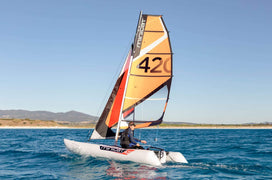
MiniCat 420
$ 7,700.00 $ 6,700.00 and up
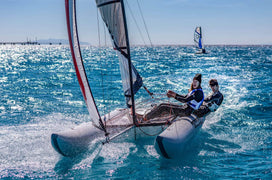
MiniCat 460
$ 9,800.00 $ 8,950.00 and up
Sign Up for Our Newsletter
Receive exclusive offers, and be the first to know about upcoming events, demos, sales, and discounts.
HOME / INDEX PAGE

Cat 22 Boat Plans…
$ 325.00 – $ 350.00

Cat 22 Boat Plans (CT22)
[CT22] Boat plans for a 22′ modern catamaran for twin outboards.
Description
Additional information.
- Reviews (0)
This design sat on our drafting table for almost 20 years. It started with somebody showing me the lines of a cat used by the Australian Coast Guard and asking for an epoxy-plywood version. We did not go very far. A catamaran cost more in material and labor than a monohull and after a quick estimate, the project went on the back burner.
Over the years, the same request came back regularly and as many of our builders have proven that they can successfully tackle elaborate projects, I went back to the drawing board and here is the result, our Cat 22 (CT22).
Click here to see study plans
Related kits:, cnc kit – marinepoxy kit – silvertip epoxy kit.
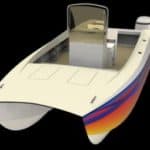
There are no reviews yet.
Your email address will not be published. Required fields are marked *
Your review *
Name *
Email *
Save my name, email, and website in this browser for the next time I comment.
You may also like…

Pettit EZ-Poxy Polyurethane Topside Finish Gallons
- $ 148.60 – $ 162.73
- Select options

Pettit EZ-Poxy Topside Paint Performance Enhancer, 8 oz.
- $ 31.05
- Add to cart

MarinEpoxy-Fiberglass Kit Cat 22 (CT22)
- $ 4,156.00
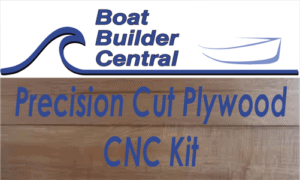
Cat 22 CT22-CNC Kit
- $ 8,627.90

SilverTip Epoxy-Fiberglass Kit Cat 22 (CT22)
- $ 5,544.72
Privacy Overview

- No products in the cart.
Catamarans and Trimarans
Catamaran and Trimaran Boat Plans make it a reality to build your own catamaran or trimaran. Multi-hulled sailing vessels are a special class of boat. A very different mind set is required when thinking about sailing a multi hull, let alone getting your head around building one.
There are some unique challenges building a multi-hull sail boat, the extra beam added by each hull for instance can create storage issues while under construction. Hartley boat plans make the build process straight forward for even amateur builders. However with all things considered, building a multi can be an amazing journey.
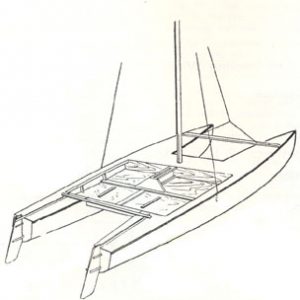
Fast Twin Catermaran
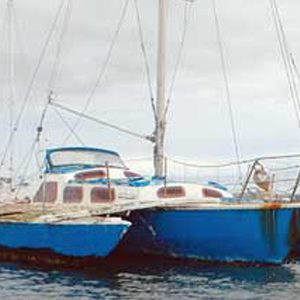
Lively 28 Cruising Trimaran
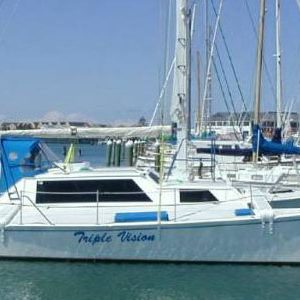
Lively 35 Cruising Trimaran

- Plans & Kits
- Plans by type
- Qty in Cart
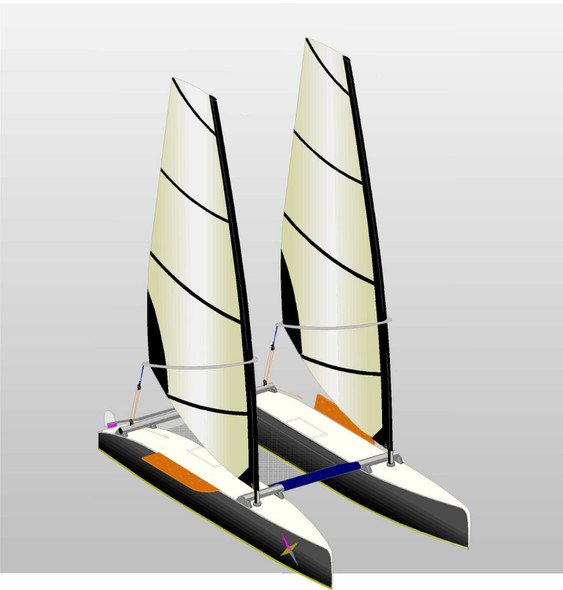
DUO 480 Adventure

DUO 900 Study Plans

DUO 900 Plans
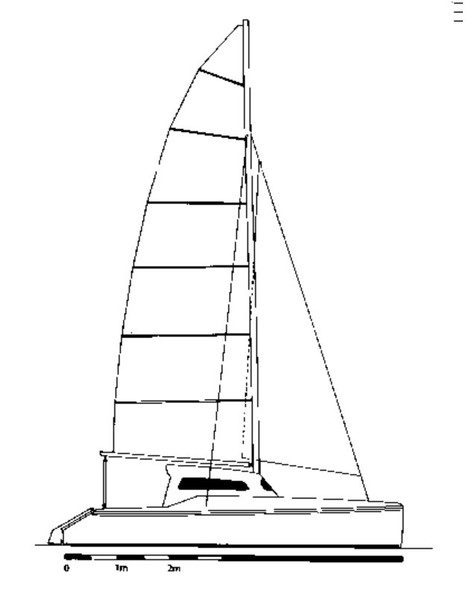
Wizard Study Plans Download

Wizard Plans Download
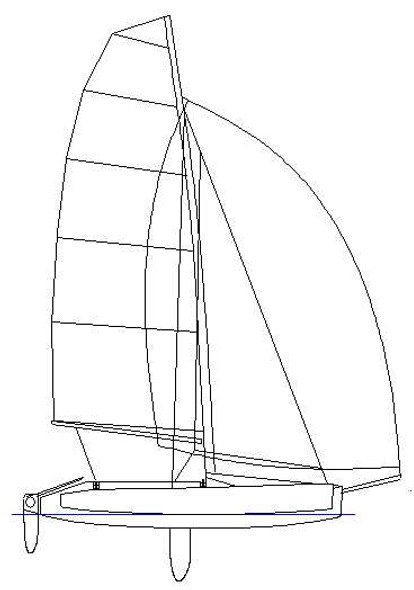
Strike 20 racing trimaran using a F18 beach cat for hulls and rig

Strike 16 Main Hull Only Plans Download
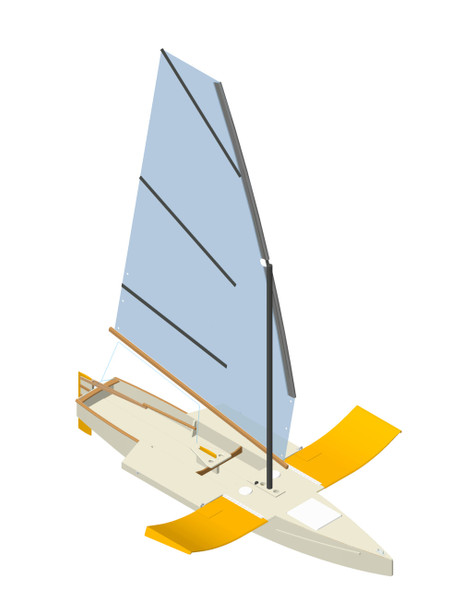
Wingmaran 15 Study Plans Download

Wingmaran 15 Plans and Templates Download
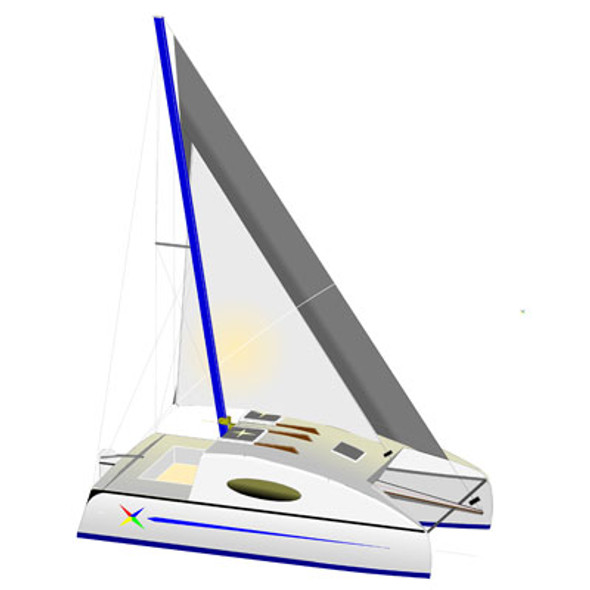
ECO 520 PDF

MaXi The Cat Plans PDF

Janus (full plans) Download
- Total: items /
- Add all to cart
Adding your products to cart

- Tokyo Express
- Small Boats
- Geelong Model 850
- Plans (all)
- Noosa Plans
- Tewantin Plans
- Geelong Plans
- Daggerboard Plans
- Daggerboards
- Consulting / Drafting
- Terms & Conditions
- Privacy Policy
Select Page
Life’s simple pleasures
Creating in your shed….
Small boats are fun to make, and even more fun when you are finished. A few basic tools and a small amount of room, a single-car garage will do just fine. Turn heads when you head to the water, with something you created yourself.
Plans – Noosa
3.4m (11′) long – small enough to build in your garage and narrow enough to walk to the water.
Simple to build, with 6 mm (1/4in) plywood, she gets up and planes with a 3.3hp motor. Click on the picture to learn more. Recommended motor size 3.3—5hp.
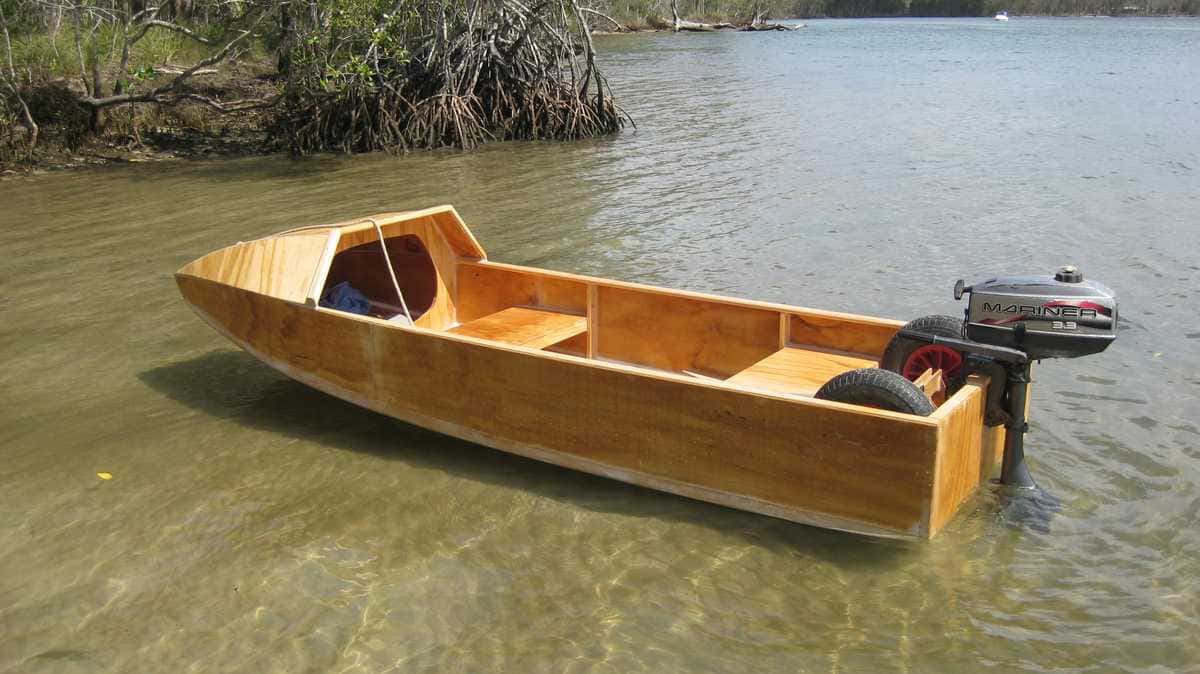
Plans – Tewantin
3.4m (11′) long – a high-speed runabout you can make in your garage. This boat flies. Light enough to load on top of your car.
Max motor size is 15hp, recommended is 6-10hp. 62 pages of detailed technical drawings, magazine-style notes and more, to help you build Tewantin.
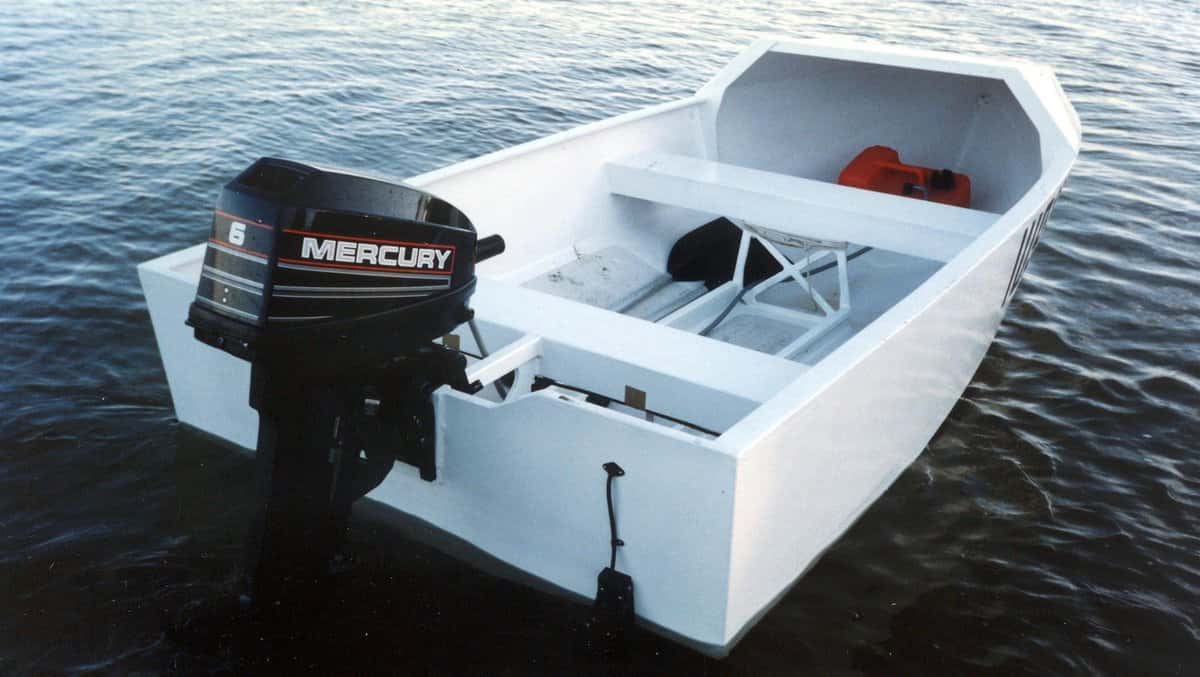
Plans – Geelong
4.7m (15.4′) long – but narrow enough to walk to the water. Another boat you can build in your garage.
Choose how you rig her. Cat rigged as in the photos (very simple), or try a Gaff rig for more sail area with the same size mast.
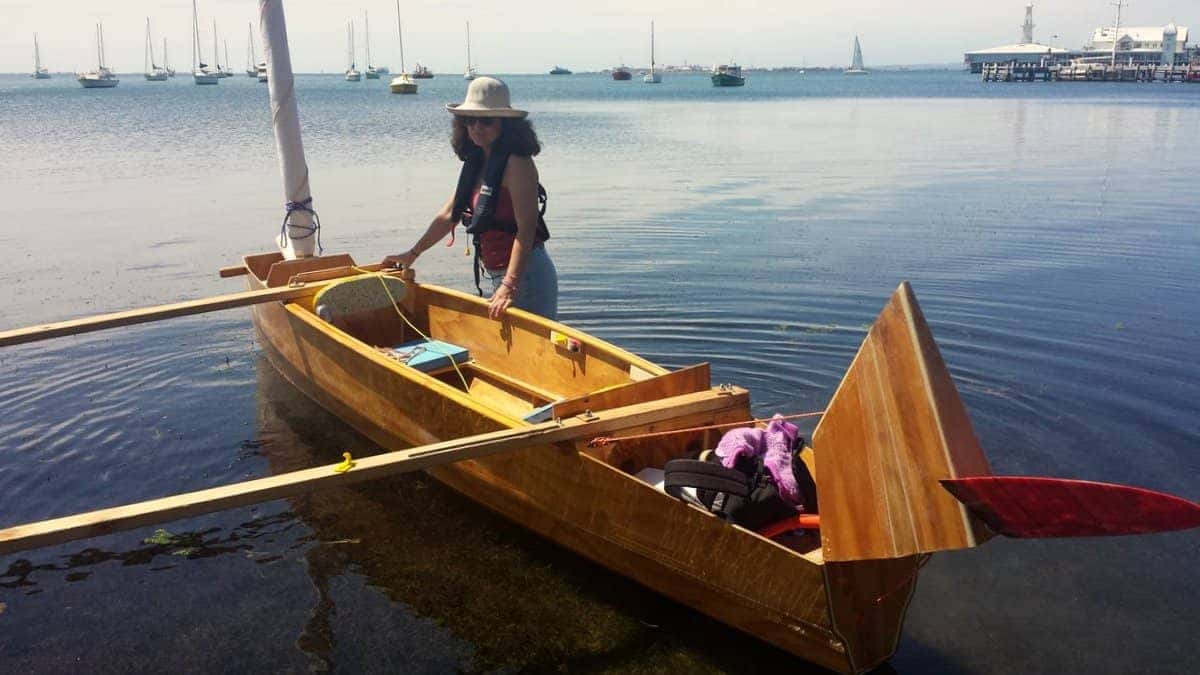
Plans – Geelong Model 850
0.85m (33″) long – small enough to build on your kitchen table but large enough to go sailing.
This boat is a replica of the full-size Geelong. If you don’t have room to build a full-size boat, you can still have fun building this boat (and take it sailing).
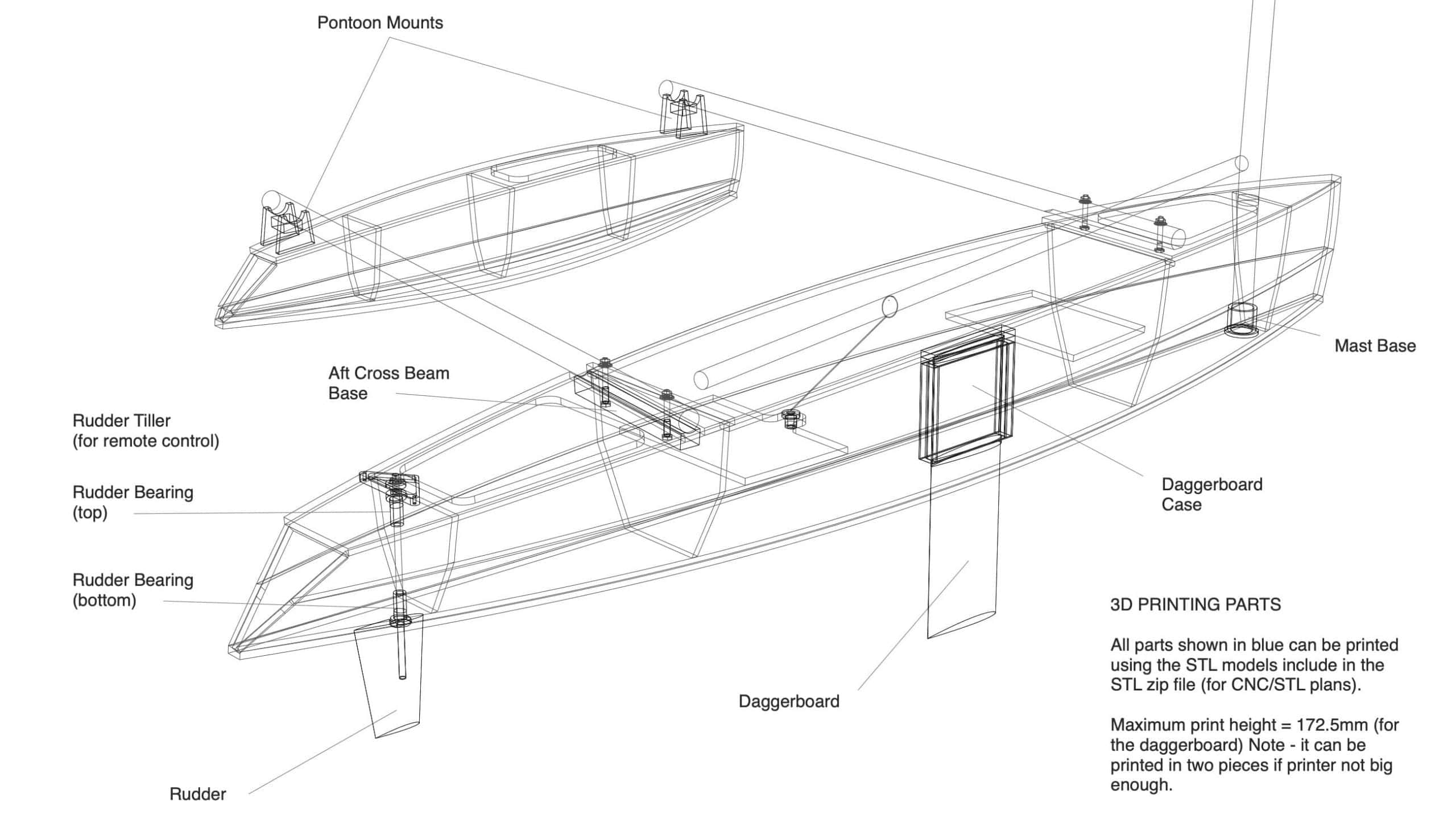
Tim Weston Boats
2022©timwestonboats.com
[email protected]
Privacy Overview

IMAGES
VIDEO
COMMENTS
Our construction plans and kits are sold with 100% professional boatbuilder support via phone and email, any time you're unsure or just need a second opinion, we're here. ... The first step to building your dream catamaran begins with a strongback - this is a square frame used to position the temporary frames that will be used to form the ...
Epoxy Wood Dinghy. The book is divided into 2 parts: the first one tells and explains the whole construction (24 pages). The second part includes all the plans as well as some photos of the construction and the annex in its final version. The plans for the Epoxy Wood Dinghy. With this little book in hand, you will be able to build your own annex.
If you were to build a 40-foot (12.1-meter) catamaran, your cost of materials would range between 20-30% of the total cost. Therefore, for $300,000 total, the boat's materials would range between $60,000 and $90,000. The hull tends to range between 15-35% of the total build.
The first step is to decide on the design and the materials you will use. You will need plans for the project, along with lumber and other materials such as fiberglass and epoxy. The next step is to build the catamaran frame, which involves cutting and fitting the wood pieces together to form the hulls and decks.
MiniCat is the answer to the regular portability and storage issues associated with small sailboat ownership and sailing affordability. MiniCat allows all to sail: young (and not so young) beginners and experienced sailors, apartment dwellers, and superyacht owners. Packed in 1-3 bags, the MiniCat inflatable catamaran is easy to transport by ...
ECO 55 Power Cat Plans. The ECO 55 power catamaran is an affordable DIY power catamaran. As the owner proved the boat is a capable coastal cruiser. The inside layout is the same as for the ECO55 sail version but the underwater shape is changed. The cockpit is wider and has a size of 1,45m x 2 m. With the bigger size normal deck chairs can be used.
High performance 55 ft² sail plan makes this small sailboat akin to a performance sailing dinghy. 2. ... Independently owned, Red Beard Sailing is your one-stop-shop for mini catamaran, small catamaran boats, inflatable dinghies, sailing accessories, & more. (410) 705-5026 Please feel free to contact us, day or night. If we are up and awake we ...
We have plans to build our own catamaran. And we're going to take you through the process on how it's done!Using a Schionning 1200 as an example, we walk yo...
LOA: 15'-6"; LWL : 13'-9"; Beam: 6'-11"; Draft: 10". Weight of structure: 450 Lbs. Materials: Marine plywood, epoxy. Maximum capacity: 8 persons. The Flat Cat hull is a new and efficient concept and is within the capabilities of many amateurs to build. The hull is a "false" catamaran with a tunnel that's partially immersed.
MAY 2012. MINI-CAT. The PortableBoatPlans "2012 Portable Boat Design Contest" is over for another year, and there were two winners (tied votes). The object of the contest was simple: Develop a concept for a small homemade boat that would appeal to many other amateur builders. This year the co-winners both provided a design for a catamaran hull ...
archie1492 Junior Member. Dear all, I want to create a detailed building information model for a 13 - 15 meter catamaran that is capable of being CNC cut and assembled. I need some help finding plans I can use as a basis of design. Specifically, I need the hull profile information. Section cuts through the hull will give me the ideal contours ...
Catamaran Stock Plans. ... Plans are leased to build ONE boat, NO time limit. Tri-Star designs are proven designs, sailing the seven seas since 1964. Free consultation is provided to the original non-professional builder till he or she is sailing the seven seas. All boats may be built with flared hulls, with the exception of the TRI 25, TRI ...
We provide stock boat plans for both monohull and multihull sailing vessels, including sailing skiffs and sharpies. Our designs mainly feature timber construction, in plywood or cedar strip plank composite construction, using the W.E.S.T. system (wood epoxy saturation technique). Our designs are intended mainly as cruising boats, although ...
The Best Advanced Build System in the World. The Schionning Advanced Build System are one of the simplest ways to build your own boat, or have a custom design built faster and more accurately by a professional. Utilising DuFlex panels with a balsa core, large sheets are joined on their long edge to form full length hull panels, bulkheads etc ...
MINICAT 420. MiniCat 420 is the most popular small inflatable catamaran sailboat from the MiniCat range, offering a great choice of models for all sailing skill levels. From the simple M420 Instinct with Dacron sails and no boom to the funky black carbon version M420 Evoque with monofilm transparent sail equipped with all the small benefits you ...
Red Beard Sailing is a premier distributor for XCAT, MiniCat, ROWonAIR, Happy Cat, Grabner, and Takacat. Independently owned, Red Beard Sailing is your one-stop-shop for mini catamaran, small catamaran boats, inflatable dinghies, sailing accessories, & more. (410) 705-5026 Please feel free to contact us, day or night. If we are up and awake we ...
PLANS & FULL SIZE PATTERNS FOR ALUMINUM STEEL or FIBERGLASS CONSTRUCTION. The CATAMARAN 65 MS was designed for personal use or charter work or as a people carrier and the accommodation was laid out with that in mind. There will be two basic layouts - personal arrangement as shown here plus an arrangement more suitable for charter use.
Catamarans; Sailing Yachts . All Sailing Yachts; Yachts 20' to 24' Yachts 24' to 35' Yachts 35' + Catamarans; Steam & Electric Boats . ... To download plans click HERE The idea for the 1 Wedge1 Sheet Wedge came from my desire for a simple, low cost, yet useful small portable hull design. It includes an ample beam and freeboard, decent volume ...
In the meantime, with the plans of the MINI-CAT complete, construction work should get underway this summer. The materials list consists of 2 sheets of 5 MM plywood, and 1 sheet of 1/2 inch plywood, in its basic form. Additional materials, like 1 x 2 lumber and TiteBond 3 waterproof wood glue complete the list.
A catamaran cost more in material and labor than a monohull and after a quick estimate, the project went on the back burner. Over the years, the same request came back regularly and as many of our builders have proven that they can successfully tackle elaborate projects, I went back to the drawing board and here is the result, our Cat 22 (CT22).
Genuine Hartley Boatplans and Samson Boatplans are only supplied by hartley-boats.com, New Zealand. Catamaran & Trimaran Boat Plans from Hartley Boats make it a reality to build your own multihull at home. Build with Plywood or Fibre Glass. 12-35 ft plans.
DUO 900 Study Plans For full plans click HERE The DUO 900 is a quick-to-build, open-bridge catamaran with asymmetrical hulls. The boat was designed for a French fighter pilot who lived in Argentina. ... The ECO 520 is the next catamaran from my jigsaw series. The first was the DUO 480 C. For study plans, click HERE The clue is, that the hulls ...
Plans - Tewantin. 3.4m (11′) long - a high-speed runabout you can make in your garage. This boat flies. Light enough to load on top of your car. Max motor size is 15hp, recommended is 6-10hp. 62 pages of detailed technical drawings, magazine-style notes and more, to help you build Tewantin.